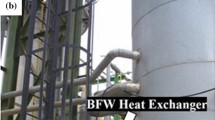Abstract
A cupronickel heat exchanger failed after 10 years of service. The cooling heat exchanger was in service in a marine environment, with water flowing along shellside and natural gas along tubeside. Many tubes showed leakages during a regular maintenance test. A comprehensive failure analysis of the heat exchanger revealed the de-nickelification process on the external side of the damaged tubes (shellside). The de-nickelification originated from a large deposit of sea water scale, over tube lengths, which completely covered the area just outside the internal portion of the tubesheet, and occurred because of a failure of the regular cleaning operation. Stagnant water and possible hot spot formations on the tubes probably caused the phenomenon.










Similar content being viewed by others
References
Pugh, S., Hewitt, G.F., Müller-Steinhagen, H.: In: Watkinson, P., Müller-Steinhagen, H., Reza Malayeri, M. (eds.) Proceedings Conference on ‘Heat Exchanger Fouling and Cleaning: Fundamentals and Applications’, Santa Fe, May 2003, Paper 3
Zhu, X., Lei, T.: Characteristics and formation of corrosion product films of 70Cu–30Ni alloy in seawater. Corros. Sci. 44, 67–79 (2002)
Wang, Y.Z., Beccaria, A.M., Poggi, G.: The effect of temperature on the corrosion behaviour of a 70/30 Cu–Ni commercial alloy in seawater. Corros. Sci. 36(8), 1277–1288 (1994)
Chauhan, P.K., Gadiyar, H.S.: An XPS study of the corrosion of Cu-10 Ni alloy in unpolluted and polluted sea-water; the effect of FeSO4 addition. Corros. Sci. 25(1), 55–68 (1985)
Mansfeld, F., Little, B.: Microbiologically influenced corrosion of copper-based materials exposed to natural seawater. Electrochim. Acta 37(12), 2291–2297 (1992)
Tuthill, A.H.: Guidelines for the use of copper alloys in seawater. Voluntary paper submitted for publication, Blacksburg, VA (1987)
Martin, J.R., Heidersbach, R.H., Lenard, D.R.: In: Proceedings Conference on ‘Corrosion/99’, Houston, 1999. NACE International, Houston, Paper 314
Xiangyang, M., Feng, F., Jianqing, J., Rongsheng, T.: Effect of rare earths on corrosion resistance of Cu–30Ni alloys in simulated seawater. J. Rare Earths 27(6), 1037–1041 (2009)
Buschow, K.H.J.: Encyclopedia of Materials: Science and Technology, 1st edn., pp. 1701–1707. Pergamon, New York (2001)
Becker, W.T., Shipley, R.J.: ASM Metals Handbook: Failure Analysis and Prevention, vol. 11. pp. 178, 201–202, 633–634. ASM International, Metals Park (2002)
Cramer, S.D., Covino, Jr. B.S.: ASM Metals Handbook: Corrosion, vol. 13B. ASM International, Metals Park (2005)
Shams El Din, A.M., El Dahshan, A.E., Taj El Din, A.M.: Dissolution of copper and copper–nickel alloys in aerated dilute HCl solutions. Desalination 130, 89–97 (2000)
Author information
Authors and Affiliations
Corresponding author
Rights and permissions
About this article
Cite this article
Cincera, S., Barella, S., Bellogini, M. et al. De-nickelification of 70/30 Cupronickel Tubing in a Cooling Heat Exchanger. J Fail. Anal. and Preven. 12, 300–304 (2012). https://doi.org/10.1007/s11668-012-9565-1
Received:
Published:
Issue Date:
DOI: https://doi.org/10.1007/s11668-012-9565-1




